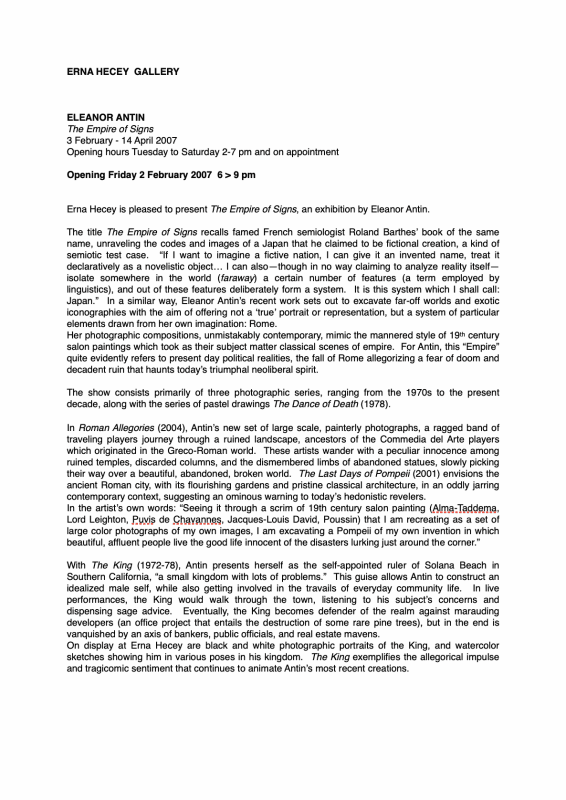Erna Hecey is pleased to present The Empire of Signs, an exhibition by Eleanor Antin.
The title The Empire of Signs recalls famed French semiologist Roland Barthes’ book of the same name, unraveling the codes and images of a Japan that he claimed to be fictional creation, a kind of semiotic test case. “If I want to imagine a fictive nation, I can give it an invented name, treat it declaratively as a novelistic object… I can also—though in no way claiming to analyze reality itself—isolate somewhere in the world (faraway) a certain number of features (a term employed by linguistics), and out of these features deliberately form a system. It is this system which I shall call: Japan.” In a similar way, Eleanor Antin’s recent work sets out to excavate far-off worlds and exotic iconographies with the aim of offering not a ‘true’ portrait or representation, but a system of particular elements drawn from her own imagination: Rome.
Her photographic compositions, unmistakably contemporary, mimic the mannered style of 19th century salon paintings which took as their subject matter classical scenes of empire. For Antin, this “Empire” quite evidently refers to present day political realities, the fall of Rome allegorizing a fear of doom and decadent ruin that haunts today’s triumphal neoliberal spirit.
The show consists primarily of three photographic series, ranging from the 1970s to the present decade, along with the series of pastel drawings The Dance of Death (1978).
In Roman Allegories (2004), Antin’s new set of large scale, painterly photographs, a ragged band of traveling players journey through a ruined landscape, ancestors of the Commedia del Arte players which originated in the Greco-Roman world. These artists wander with a peculiar innocence among ruined temples, discarded columns, and the dismembered limbs of abandoned statues, slowly picking their way over a beautiful, abandoned, broken world. The Last Days of Pompeii (2001) envisions the ancient Roman city, with its flourishing gardens and pristine classical architecture, in an oddly jarring contemporary context, suggesting an ominous warning to today’s hedonistic revelers.
In the artist’s own words: “Seeing it through a scrim of 19th century salon painting (Alma-Taddema, Lord Leighton, Puvis de Chavannes, Jacques-Louis David, Poussin) that I am recreating as a set of large color photographs of my own images, I am excavating a Pompeii of my own invention in which beautiful, affluent people live the good life innocent of the disasters lurking just around the corner.”
With The King (1972-78), Antin presents herself as the self-appointed ruler of Solana Beach in Southern California, “a small kingdom with lots of problems.” This guise allows Antin to construct an idealized male self, while also getting involved in the travails of everyday community life. In live performances, the King would walk through the town, listening to his subject’s concerns and dispensing sage advice. Eventually, the King becomes defender of the realm against marauding developers (an office project that entails the destruction of some rare pine trees), but in the end is vanquished by an axis of bankers, public officials, and real estate mavens.
On display at Erna Hecey are black and white photographic portraits of the King, and watercolor sketches showing him in various poses in his kingdom. The King exemplifies the allegorical impulse and tragicomic sentiment that continues to animate Antin’s most recent creations.
Eleanor Antin, a pioneering conceptual and multidisciplinary artist, has been creating narrative images in photography, video and film, performance, and installation for more than 35 years. One of her most famous works is 100 Boots, a conceptual series of 51 pictures of black rubber boots photographed all over the United States from 1971 to 1973. This epic visual narrative is a milestone in postmodern art, uniting the romantic and the political.
By sending out the pictures as postcards, Antin was one of the first artists to use mail as a medium.
In many of her works, Eleanor Antin uses fictive personae to explore the idea of the self and investigate the construction of identity. Her performances feature a recurring set of ‘historical’ characters—past lives invented and acted out by Antin, including Nurse Eleanor of the Crimean War, the Russian ballerina Eleanora Antinova, and the King of Solana Beach. Her narrative strategies are often comedic send-ups of cultural, political and sexual clichés with dark undertones.
Antin's 2002 photographic exhibition at the Ronald Feldman Gallery, “The Last Days of Pompeii”, received the AICA (International Association of Art Critics) First Place award for Best Show by a Mid-Career Artist. Those works traveled to Vienna, Milan, Los Angeles, San Diego, and elsewhere. She has had numerous solo exhibitions, including the Museum of Modern Art, the Whitney Museum, the Wadsworth Atheneum, and a major retrospective at the Los Angeles County Museum of Art in 1999 which traveled to the Washington University Museum in Saint Louis before touring the UK.
She is represented in major public collections including the Art Institute of Chicago, the Whitney Museum, the Museum of Modern Art, the Los Angeles County Museum of Art, the Jewish Museum, the San Francisco Museum of Modern Art, the Witherspoon Art Museum, the Beaubourg in Paris, and others.

